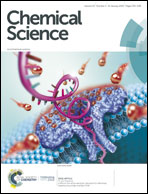Three to tango requires a site-specific substitution: heterotrimetallic molecular precursors for high-voltage rechargeable batteries†
Abstract
Design of heterotrimetallic molecules, especially those containing at least two different metals with close atomic numbers, radii, and the same coordination number/environment is a challenging task. This quest is greatly facilitated by having a heterobimetallic parent molecule that features multiple metal sites with only some of those displaying substitutional flexibility. Recently, a unique heterobimetallic complex LiMn2(thd)5 (thd = 2,2,6,6-tetramethyl-3,5-heptanedionate) has been introduced as a single-source precursor for the preparation of a popular spinel cathode material, LiMn2O4. Theoretical calculations convincingly predict that in the above trinuclear molecule only one of the Mn sites is sufficiently flexible to be substituted with another 3d transition metal. Following those predictions, two heterotrimetallic complexes, LiMn2−xCox(thd)5 (x = 1 (1a) and 0.5 (1b)), that represent full and partial substitution, respectively, of Co for Mn in the parent molecule, have been synthesized. X-ray structural elucidation clearly showed that only one transition metal position in the trinuclear molecule contains Co, while the other site remains fully occupied by Mn. A number of techniques have been employed for deciphering the structure and composition of heterotrimetallic compounds. Synchrotron resonant diffraction experiments unambiguously assigned 3d transition metal positions as well as provided a precise “site-specific Mn/Co elemental analysis” in a single crystal, even in an extremely difficult case of severely disordered structure formed by the superposition of two enantiomers. DART mass spectrometry and magnetic measurements clearly confirmed the presence of heterotrimetallic species LiMnCo(thd)5 rather than a statistical mixture of two heterobimetallic LiMn2(thd)5 and LiCo2(thd)5 molecules. Heterometallic precursors 1a and 1b were found to exhibit a clean decomposition yielding phase-pure LiMnCoO4 and LiMn1.5Co0.5O4 spinels, respectively, at the relatively low temperature of 400 °C. The latter oxide represents an important “5V spinel” cathode material for the lithium ion batteries. Transmission electron microscopy confirmed a homogeneous distribution of transition metals in quaternary oxides obtained by pyrolysis of single-source precursors.



 Please wait while we load your content...
Please wait while we load your content...